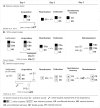Updating fearful memories with extinction training during reconsolidation: a human study using auditory aversive stimuli
- PMID: 22768048
- PMCID: PMC3387215
- DOI: 10.1371/journal.pone.0038849
Updating fearful memories with extinction training during reconsolidation: a human study using auditory aversive stimuli
Abstract
Learning to fear danger in the environment is essential to survival, but dysregulation of the fear system is at the core of many anxiety disorders. As a consequence, a great interest has emerged in developing strategies for suppressing fear memories in maladaptive cases. Recent research has focused in the process of reconsolidation where memories become labile after being retrieved. In a behavioral manipulation, Schiller et al., (2010) reported that extinction training, administrated during memory reconsolidation, could erase fear responses. The implications of this study are crucial for the possible treatment of anxiety disorders without the administration of drugs. However, attempts to replicate this effect by other groups have been so far unsuccessful. We sought out to reproduce Schiller et al., (2010) findings in a different fear conditioning paradigm based on auditory aversive stimuli instead of electric shock. Following a within-subject design, participants were conditioned to two different sounds and skin conductance response (SCR) was recorded as a measure of fear. Our results demonstrated that only the conditioned stimulus that was reminded 10 minutes before extinction training did not reinstate a fear response after a reminder trial consisting of the presentation of the unconditioned stimuli. For the first time, we replicated Schiller et al., (2010) behavioral manipulation and extended it to an auditory fear conditioning paradigm.
Conflict of interest statement
Figures



Similar articles
-
Extinction during reconsolidation eliminates recovery of fear conditioned to fear-irrelevant and fear-relevant stimuli.Behav Res Ther. 2017 May;92:1-10. doi: 10.1016/j.brat.2017.01.017. Epub 2017 Feb 2. Behav Res Ther. 2017. PMID: 28171767
-
Disruption of human fear reconsolidation using imaginal and in vivo extinction.Behav Brain Res. 2017 Feb 15;319:9-15. doi: 10.1016/j.bbr.2016.11.014. Epub 2016 Nov 10. Behav Brain Res. 2017. PMID: 27840245
-
Impact of a reminder/extinction procedure on threat-conditioned pupil size and skin conductance responses.Learn Mem. 2020 Mar 16;27(4):164-172. doi: 10.1101/lm.050211.119. Print 2020 Apr. Learn Mem. 2020. PMID: 32179658 Free PMC article.
-
Erasing fear memories with extinction training.J Neurosci. 2010 Nov 10;30(45):14993-7. doi: 10.1523/JNEUROSCI.4268-10.2010. J Neurosci. 2010. PMID: 21068303 Free PMC article. Review.
-
Translational Approaches Targeting Reconsolidation.Curr Top Behav Neurosci. 2016;28:197-230. doi: 10.1007/7854_2015_5008. Curr Top Behav Neurosci. 2016. PMID: 27240676 Free PMC article. Review.
Cited by
-
Offline tDCS modulates prefrontal-cortical-subcortical-cerebellar fear pathways in delayed fear extinction.Exp Brain Res. 2022 Jan;240(1):221-235. doi: 10.1007/s00221-021-06248-9. Epub 2021 Oct 25. Exp Brain Res. 2022. PMID: 34694466
-
Testing the memory reconsolidation hypothesis in a fear extinction paradigm: The effects of ecological and arbitrary stimuli.Learn Behav. 2022 Sep;50(3):417-432. doi: 10.3758/s13420-022-00536-2. Epub 2022 Jun 16. Learn Behav. 2022. PMID: 35710961
-
The computational nature of memory modification.Elife. 2017 Mar 15;6:e23763. doi: 10.7554/eLife.23763. Elife. 2017. PMID: 28294944 Free PMC article.
-
Memory Reconsolidation Interference as an Emerging Treatment for Emotional Disorders: Strengths, Limitations, Challenges, and Opportunities.Annu Rev Clin Psychol. 2017 May 8;13:99-121. doi: 10.1146/annurev-clinpsy-032816-045209. Epub 2017 Mar 27. Annu Rev Clin Psychol. 2017. PMID: 28375725 Free PMC article. Review.
-
Effects of transcranial direct current stimulation on neural activity and functional connectivity during fear extinction.Int J Clin Health Psychol. 2023 Jan-Apr;23(1):100342. doi: 10.1016/j.ijchp.2022.100342. Epub 2022 Oct 15. Int J Clin Health Psychol. 2023. PMID: 36299490 Free PMC article.
References
-
- Phelps EA, Ledoux JE. Contributions of the amygdala to emotion processing: from animal models to human behavior. Neuron 20. 2005;48(2):175–87. - PubMed
-
- Rauch SL, Shin LM, Phelps EA. Neurocircuitry models of posttraumatic stress disorder and extinction: human neuroimaging research–past, present, and future. Biol Psychiatry 15. 2006;60(4):376–82. - PubMed
-
- Lang PJ, Davis M, Ohman A. Fear and anxiety: animal models and human cognitive psychophysiology. J Affect Disord. 2000;61(3):137–59. - PubMed
-
- Maren S. Neurobiology of Pavlovian fear conditioning. Annu Rev Neurosci. 2001;24:897–931. - PubMed

